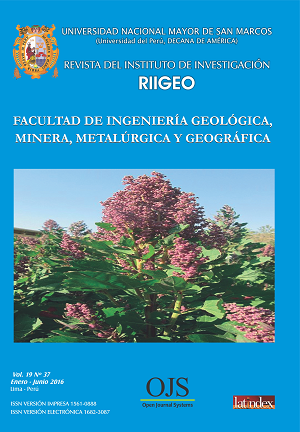Emerging basins, hydrocarbon potential of the Jurassic and Paleozoic carbonate reservoirs in the peruvian sub-andean belt
DOI:
https://doi.org/10.15381/iigeo.v19i37.12963Keywords:
Carbonates, Tarma Group, Copacabana Group, Paleozoic, Jurassic, deposit environment, petrophysics, geophysicsAbstract
The carbonate rocks in the world produce about 60% of the world consumption of hydrocarbons, the largest production of these reservoirs come from the Middle East. In Peru we produce sandstones that belong to the group of clastic rocks that historically in the world were the targets that stored hydrocarbons. The objective of this study is to propose new reservoirs in carbonate rocks to explore for hydrocarbons in Peru, to delimit the places where the greatest thickness has been deposited and the areas within the Peruvian territory; the Copacabana and Tarma groups belonging to the Paleozoic and the Pucará group belonging to the Mesozoic are the two largest carbonate deposits with the greatest distribution in the country. The Copacabana - Tarma groups have an areal distribution that covers almost all of Peru and includes Ecuador, Brazil, Colombia, Bolivia and northern Chile, these carbonates that belong to an open sea deposit environment, fed by the Panthalassic sea which corresponds to the time when the continent was united with Africa and North America, in Peru we find it distributed along the Andean Cordillera and in the sub-Andean region throughout the jungle from Loreto to Madre de Dios, including the basins prospects for hydrocarbons from Madre de Dios and Ucayali where it is buried and could be explored. The Pucará Group has an area distribution that includes the central and northern zones of the Andean mountain range and the western part of the sub-Andean jungle of Ucayali and Loreto that includes the Ucayali and Marañón basins where it is buried and with the possibility of being explored by hydrocarbons. . These basins with potential to explore for hydrocarbons in these proposed reservoirs are new and therefore new emerging basins for Paleozoic and Jurassic hydrocarbons are considered.
Downloads
Published
Issue
Section
License
Copyright (c) 2016 Marco Antonio Vásquez Flores

This work is licensed under a Creative Commons Attribution-NonCommercial-ShareAlike 4.0 International License.
AUTHORS RETAIN THEIR RIGHTS:
a. Authors retain their trade mark rights and patent, and also on any process or procedure described in the article.
b. Authors retain their right to share, copy, distribute, perform and publicly communicate their article (eg, to place their article in an institutional repository or publish it in a book), with an acknowledgment of its initial publication in the Rev. Inst. investig. Fac. minas metal cienc. geogr.
c. Authors retain theirs right to make a subsequent publication of their work, to use the article or any part thereof (eg a compilation of his papers, lecture notes, thesis, or a book), always indicating the source of publication (the originator of the work, journal, volume, number and date).






